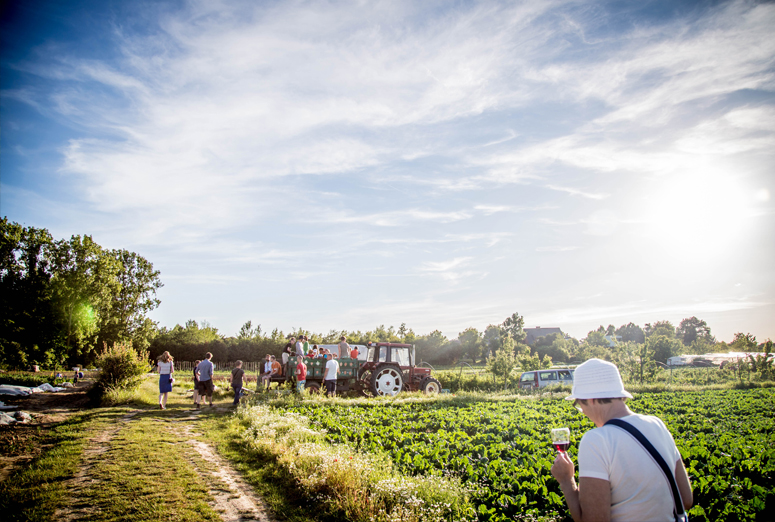Good, seasonal food, a nature-friendly approach and a fair price for farmers. Could Community-Supported Agriculture (CSA) transform our food system? In the second of our series on Agroecology, Asger Mindegaard guides us through the issues.
Warning: you might want to join the nearest CSA farm after reading.
“It’s really encouraging to hear a nice story from time to time, for example, from someone who says that his children are eating vegetables now that they come from this field,” says Tom Troonbeeckx, the hands and brains behind Belgium’s first community-supported agriculture (CSA) farm.
Back in 2007, Troonbeeckx bought an old cherry orchard and an adjacent plot of land close to Leuven, some 20km east of Brussels. He started Het Open Veld (Dutch for ‘The Open Field’) with the support of some 50 local clients. Fast forward 13 years, Tom’s modest 1.5 hectares provide fresh food all year around to 320 locals. And the waiting list to become a customer at Boerencompagnie (as the farm is now called) is long.
What makes Tom’s farm so special? The answer lies both in his farming philosophy and in his business model. Because, as is the case with all agroecological farming, his primary innovation is social and knowledge-based.

Sustainable farming champion
For Tom, caring for the environment is serious business. His production is organic and the little water he needs for irrigation comes from a rainwater harvesting system on the farm which is supplemented by a tiny pump. A handful of cows and sheep help with essential grazing and provide the little fertiliser needed, because Tom ensures his soil is fertile through crop rotation, intercropping and fallows. Some 20 chickens, two mules and a few pigs also live on the farm.
Biodiversity is a high priority on Tom’s farm. The pollination of fruit trees and vegetables is guaranteed by several honey bee colonies and there is plenty of space for wild fauna on the farm. Genetic diversity of crops is also a priority and Tom is actively working to preserve and reintroduce old crop species, to the delight of his customers’ taste buds.
With clients arriving mostly by foot or bike, harvesting the produce themselves in the field and bringing it directly home, GHG emissions, pollution and packaging is kept to an absolute minimum. This is in stark contrast to the extensive footprint of most modern food supply chains.
Nearest and dearest
Despite the deep dedication to sustainable production, what truly distinguishes Tom from most European farmers is his business model. It is all about trust and community.
Customers and farmer come together in a General Assembly to agree on the production strategy of the farm and on Tom’s salary. Tom provides the annual average contribution he needs per customer to run the farm, but customers decide themselves how much they pay each year (within a range) for the right to harvest as much food as they need. Everything paid goes back into the production and to sustain Tom’s livelihood.
“Since I am not into international markets or the multinational economic system, I can create my own economy,” Tom explained to Politico. And this statement is to be taken literally, as Tom does not receive EU support, which many EU farmers depend heavily on.
Tom’s farming model is spreading steadily. Today, there are more than 50 CSA farms in Belgium and the number is growing. And in the rest of Europe, the trend is catching on too.

Chain reactions
The current COVID-19 crisis is putting globalised food supply chains under huge pressure by threatening the movement of people and goods, even within the EU. This challenges the Europe’s predominant agricultural model, which relies on a high degree of specialisation: farms (and sometimes entire regions) specialise in just a few crops often loaded into trucks and sold far away.
This means that massive influxes of labour for harvest are required during very narrow windows of time when these few crops are ripe. The labour often comes from Eastern Europe and North Africa, making the entire harvest vulnerable to restrictions on cross-border movement. We also see challenges to global supply chains and FAO (the food and agriculture branch of the United Nations) estimate that it is the need for high mobility, and not the production of food that threatens EU food supplies, with reported disruptions to the shipping industry on the near horizon.
Farmers who depend on a high number of foreign seasonal workers to harvest a few types of crops for international markets accumulate a number of vulnerabilities. Economically, the farmer depends on sufficient labour at exactly the right time, regional or global demand, functioning logistics in the supply chain, and decent prices for their crops. Agronomically, a homogeneous and specialised production is more vulnerable to pests, diseases and extreme weather events which can wipe out the entire production of the year.
Strengthening supply chains
Farmers who produce a variety of crops and primarily sell directly to customers or to local retailers are much more resilient to disturbances. Diversified production means a more even distribution of harvests over the season, making the more regular labour needs easier to cover with local hands, thereby creating more stable local jobs. It also means that production is more resilient to pests, diseases and extreme weather which usually affect different crops differently. Moreover, the shorter distances and fewer intermediaries between the farmer and the consumer mean less risk of the food getting stuck when free movement is disrupted, such as has occurred with the COVID-19 crisis.
“CSA farming is about relocalising the supply chain, reinvigorating a sense of community and redefining the value of money,” explains Nick Meynen who, apart from being one of Tom’s clients, is also policy officer for environmental and economic justice at the EEB and the author of Frontlines, Stories of Global Environmental Justice, which features a chapter on Tom Troonbeeckx.
Not all food can be provided by hyper-local production and not all international trade is bad. But now is a good opportunity to reflect on the resilience of our food systems in the EU.

Resilience through agroecology
For decades, large corporations, including producers of fertiliser and pesticides, have argued that intensified industrial agriculture, turned sustainable through technological innovation, is the only way to feed the increasing global population.
But contemporary agriculture depletes agricultural soils 100 times faster than they are regenerated, drinks up 70% of global freshwater use and, together with forestry, accounts for 23% of human-induced greenhouse gas emissions. Simultaneously, expansion of agricultural activity is one of the main drivers of biodiversity collapse. Further intensification on this same path seems like a questionable way to guarantee long-term food security.
Agroecological farming (producing food while protecting ecosystems and biodiversity) seems to be a better bet in the long run. One large European research project found that a transition to 100% agroecological agriculture in the EU is fully capable of feeding the 2050 EU population of 530 million people. Agroecological farms with short supply chains, such as Tom Troonbeeckx’s CSA farm, are good examples of how to ensure long-term resilience of EU food systems – both in agronomic and in socioeconomic terms. Especially around cities and towns (accounting for 71% of the EU population), as CSA depends on the proximity of a mass of clients.
According to El País, COVID-19 has already caused a 50% increase in the demand for products from small, local agroecological farms in Spain. But a real transition requires bringing agroecology centre stage in our food systems, systematically prioritising it, rather than the marginal position it currently occupies.
Fertile ground for new policy
In this regard, the ongoing reform of the EU’s Common Agricultural Policy (CAP) is key. The CAP guides the distribution of the approximately €60 billion a year for direct payments to agriculture and to rural development and thus also what type of agriculture is incentivised. Although farmers like Tom Troonbeeckx who do not receive CAP funding exist, they are rare.
In Belgium, the differences in agricultural practices are considerable in spite of the structure of the CAP, according to Laurens De Meyer who is policy officer for agriculture and food for the Flemish EEB member Bond Beter Leefmilieu. He explains that agroecological practices are much more prevalent in Wallonia (the French speaking southern part of the country) than in Flanders (the Dutch speaking northern part). In Flanders, farming is charaterised by intensive industrial production aimed at export.
“The differences between Flanders and Wallonia shows that the CAP already gives member states the opportunity to guide the agricultural sector in one direction or another. The new CAP should definitely focus more on the transition towards good agroecological practices and urge member states to have the same focus,” Laurens De Meyer points out.
The history of environmental efforts supported by the CAP in recent decades, and the contrast between the approaches in Wallonia and Flanders, make it clear that environmental ambitions cannot be left to national governments alone. Where flexibility is offered, this overwhelmingly tends to be used to continue support for practices already in place as concluded in two recent evaluations of the CAP’s impact on biodiversity and water. The CAP must make environmentally and socioeconomically sustainable farming (e.g. agroecology) the default for EU agriculture, not a niche alternative.
Laurens De Meyer emphasises that one crucial element here is the integration of agricultural policy with other policy areas directly related to food – something the EEB has long campaigned for, in particular in the context of the upcoming Farm to Fork Strategy.



Inspiration for an agroecological Europe
As Europe battles COVID-19 the EEB is committed to continuing our work towards a better future where people and nature thrive together. Getting the future of our food and farming system right is a crucial part of it.
This article is the second in a series telling the story of agroecological farms throughout Europe. We hope to show what an agroecological future for Europe could look like, and why it’s a desirable path.
Subscribe below to be sure you don’t miss these articles and more in the coming months.


